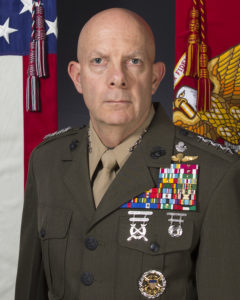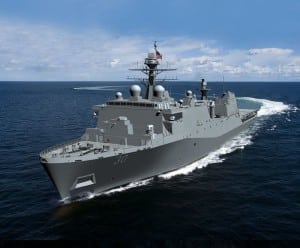Provisions in the final compromise version of the fiscal year 2023 National Defense Authorization Act directs the Commandant of the Marine Corps to have a clearer say in amphibious naval force requirements.
One section of the bill states the Commandant is “specifically responsible” for developing requirements concerning amphibious warfare ships while another directs the Navy to consult with the Marine Corps on major decisions “directly concerning Marine Corps aviation or amphibious force structure and capability.”

“It clearly states from Congress that the role of the commandant of the Marine Corps in defining requirements, that’s a very positive thing. It doesn’t say anything negative about a personal relationship between the [Chief of Naval Operations] and the commandant or the two services are bickering with each other. It just says Congress understands that that’s a service requirement so we want to hear from the service what you need. I think that’s not complicated at all,” Marine Commandant Gen. David Berger told reporters Wednesday during a Defense Writers Group event.
Berger added that while he is comfortable with the way things are moving, “this first step is just the authorization, doesn’t have a nickel in it. So we’ll wait and see what appropriations comes through with in terms of decommissioning and shipbuilding and all that kind of stuff.”
Berger also said the bill provision setting the amphibious warship floor at 31 ships allows them to stop focusing on the requirement year after year.
“Well, we can stop talking about what the requirement is year to year to year, and talk more about what we can afford, and how to use it and how to maintain it. Because the CNO wants to keep the LPD line hot also…we’re 100% in agreement there. What it does is stop talking about 31 or 35, or 38. We know what the minimum is. Now let’s talk about what we can afford.”
The Navy’s FY ‘23 budget request said it planned to end the San Antonio-class LPD-17 Flight II ships with the purchase of LPD-32 and planned to retire four older Whidbey Island-class dock landing ships (LSDs).
In April, Principal Civilian Deputy to the Assistant Secretary of the Navy for Research, Development and Acquisition Jay Stefany said the Navy wants to stop building the LPDs while it decides whether to build more or potentially start with a new or modified design (Defense Daily, April 22).
At the time, Stefany said the Navy can wait for a production decision until the FY ‘25 budget for preferred ideal production timelines since full production on LPD-32 is funded in the FY ‘23 budget request.
However, Berger put advanced procurement of LPD-33 at the top of his annual unfunded requirements wish list to Congress and the final defense authorization bill prevented the LSD retirements.

Berger argued while the Marine Corps has certain amphibious ship requirements, Navy officials like the CNO look at the larger budget picture and have multiple priorities.
“In terms of decommissioning and the cost to maintain them…the enterprise in the Navy is really big. So [the CNO] has a great sight picture on what that cost is. Congress, of course, wrote the check to buy the ships. So they want to make sure you’re not building something and then throwing it in the barn a few years later.”
He admitted while Congress has its constituencies, the Marine Corps and services only have to factor that in indirectly.
Instead, Berger said in the Marine Corps “we need to make sure the inventory of amphibious ships, combatant ships is adequate to do what the President and the Secretary need us to do based on the national defense strategy. It’s not any more complicated than that. But inventory is more than how many, it’s how many that are working, that are usable. So we can have 100 of something. But if only 20 of them are usable, then 100 is not a relevant number. It’s the 20.”
Berger said this means they have to focus on both inventory and readiness availability of amphibious ships.
“The CNO’s pretty open about it. He’s not very happy with the maintenance part of fixing them and getting them out on time. And then they get underway and break again, he’s not very happy with all of that. Making progress, but he wants to hold them accountable. Me too.”
Berger also said he thinks that “if the CNO had his druthers, he would double the number of shipyards tomorrow, because we need capacity and we need competition. We need both to get the citizens a good price on their ships, right, and quality.”
However, he warned one of the main limiting factors in shipbuilding is labor and keeping production lines active.
“We got to keep that active, warm, producing all the time. If it goes cold–hard to ring that factory back, hard to bring those workers back.”